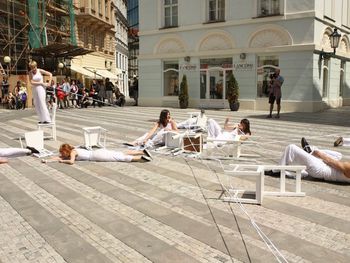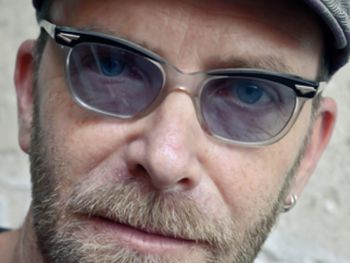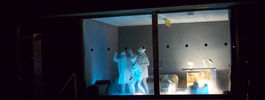Back
2011 » Georgia » Section of Countries and Regions
| Curator: | Ketevan Simon Kintsurashvili |
| Institution: | Ministry of Culture and Protection of Monuments of Georgia |
Scenography as a Technique; The Concept of Static Drama
In addition to looking at artistic issues, our theoretical objective is to explain the significance and capacities of scenography in regard to post-modern and contemporary art in general. In our view, scenography is a technique that enables artists to fill material objects with magical content and create surrealistic spaces that involve the viewer in the process of developing an idea. When the shift from modernism to post-modernism began in the West, this process involved theatre as well. The penetration of elements of theatre into the visual arts provoked a sharp reaction from and intense debate among critics. Some critics claimed that theatre and theatricality were at war with visual art, and that the latter had to defeat theatre in order to survive. Art’s association with theatre (and literature) resulted from the spectator’s new position in relation to visual art, resulting from his/her increased participation (in M. Fried’s words, “the experience of literalist art is of an object in a situation – one that, virtually by definition, includes the beholder.” From: “Art and Objecthood,” 1967). A similar antagonistic approach emerged towards space. In the Soviet Union, no one was interested in the events described above, since on this side of the Iron Curtain, avant-garde art was strictly forbidden, and so the autonomy of traditional branches of art was not under any threat. Nevertheless, even during the Cold War, this curtain was permeable and some information did make it through. It so happened that, in our part of the world, thanks to the artists with avant-garde thinking new tendencies became established on theatre stages, with scenography providing “refuge” to the avant-garde. Georgi Alexi-Meskhishvili (1941), who represents Georgia at the Veletržní Palace, was one of the leaders of these processes. Alexi-Meskhishvili did not need to break the limits of visual art through the use of theatrical elements; he solved his creative problems simultaneously in two spheres – scenography and easel painting – and elements of the new trends found their natural, organic reflection in his works. As a result, his artistic expression shifted freely from plane to space and vice versa. When he subsequently exhibited his works, the effect of theatrical play caused any means (including collage and installation) to be perceived as the scenographer’s suggestion – as a result, they were not prohibited. So, thanks to the technique of scenography, Soviet audiences were involuntarily introduced to prohibited avant-garde trends (pop art, conceptualism, informal, or site-specific art) and thus acquired the ability to think in objects charged with abstract ideas, symbols and metaphors and equipped with the tools of semiology. Georgi Alexi-Meskhishvili uses all instruments as a tool for revealing human secrets. As a result, surrealism also acquired a special, non-classical, post-modernist content in his creative work. Instead of telling or describing a secret, he reveals its existence without damaging its tender fabric. Though for the purpose of abstracting he never makes either body or thing invisible (theatre artists cannot “evade” a figure), he gives material objects (including garments) a new meaning (content). Accordingly, Alexi-Meskhishvili is capable of tearing a man off the stage boards and teaching him to fly (one example that is presented at the Nostic Palace is Ariel’s costume for Shakespeare’s “The Tempest”). At the Veletržní Palace, Alexi-Meskhishvili presents a scenographic composition dedicated to the Georgian poet Vaja-Pshavela, whose 150th anniversary is being celebrated in Georgia this year, and shows the dimensionless nature of the world of magic in both poetry and art. The accompanying music (by composer Giorgi Janiashvili) plays an important role in imbuing the presented installation with a mystic aura. At the Nostic Palace, composer Giorgi Janiashvili collaborates with designer David Janiashvili in order to present a visual-sound installation on the theme of sacrifice. This installation represents an example of “Static Drama” – a concept developed by the composer himself. The young artists’ goal is to involve the audience in the presented drama so that they influence the play with their thoughts and actions. The thus viewer becomes a participant in the process that is taking place within the installation. Static Drama presents a space born in the process of thinking, which gives birth to the new process(es) of thinking. In this case, scenography is considered a technique that allows us to give shape to an idea. Acompanying project at the Nostic Palace is non-competetiv.









































Exhibiting artists / ateliers
[show all
| hide all]
- giorgi janiaSvili (Giorgi Janiashvili)
* 26.01.1989, Tbilisi
Specialization: composer, sound artist, Multimedia Artist
Education: Student of composition at V. Sarajishvili Tbilisi State Conservatoire (2007-2009); student of composition at Trinity Laban Conservatoire of Music and Dance in London, UK (2009-present)
Participation in other important exhibitions: Royal Observatory, Greenwich/UK (2009); festivals: “Sound and Space”, “Harmony of the Spheres", sound installation and live multimedia performance ”Fortune Teller” (director, actor, composer, and sound designer)
Additional information: 2007 - Tbilisi Art Festival: multimedia performance (piano, trumpet, electronics); 2008 - Tbilisi State Conservatoire: Multimedia Performance (director, music, video, sound and lighting); 2008 – Tbilisi State Conservatoire: "Black Bird" (multimedia performance, electronic music), "Tocatta for Piano" (composer, sound, lighting and direction); 2009 – Tbilisi State Conservatoire: “Upatrono Uro” (Hammer Without a Master) for piano and electronics; 2010 – Blackheath Halls (London, UK): world premier of “io io” dedicated to Rivka Golani (for solo viola, chamber ensemble and electronics); 2010 – Trinity College of Music (London, UK): multimedia performance of the audio/video trilogy “Take a Train”, “Bad Weather”, “Train”; "Angel in the Dream" (harp and electronics, composer, director, sound, projectionist); 2010 – Club Shunt (London, UK): "Dimensions" (multimedia performance for electronics); audio/video trilogy “Take a Train”, “Bad Weather”, “Train”; 2010 – Gallery 10 Gales (London, UK): “Anarchy” dance performance by M. Brenneis, music by G. Janiashvili; 2010 – Bonnie Bird Theatre/Laban (London, UK): “Mute Codes" dance performance by M. Brenneis, music by G. Janiashvili; 2011 – Bonnie Bird Theatre/Laban, South Bank Centre (London, UK): “December 1952” dance and music performances directed by L.K. Ross, I. Mitchel, performed by Trinity Laban Conservatoire of Music and Dance Students, G. Janiashvili trumpet
Exhibiting works
-
Giorgi Janiashvili: msxverplTSewirva – statikuri drama (Sacrifice - The Static Drama),
2011, Director: Author and Director - Giorgi Janiashvili
Music and Sound Design - Giorgi Janiashvili
Design - Giorgi Janiashvili, David Janiashvili
Executive Designer - David Janiashvili, David Janiashvili - designer ; Identification of exhibit:
object, sound, installation ;
Comments: Motto: “A sacrificial body is already light.” M. Mamardashvili, “Talks about Philosophy,” 1992
The visual and sound based installation is devoted to the eternal theme of Sacrifice.
Upon entering the space, the viewer becomes immersed in an ambience of music and visual symbols that convey a ritualistic sense of sacrifice and sacrificial offering. The viewer involuntarily becomes a participant within the installation where the thematic structure looms large in the imagination. A body suspended in space represents a universal loss for the many who have perished for the sake of truth. Though an image of Christ may come to mind, the ongoing loss of so many voiceless victims and the sacrifice of the self are uniquely conveyed. A woolen coat is splayed upon the floor conveying the presence of a human being. The obvious reference of sheep is set before the audience yet they are still required to step upon and across this presence, an apt metaphor for our often-inhumane treatment of one-another. This is a symbolist world where violence is conveyed through poetry. The audience is invited to enter a realm where personal and universal experiences can be receptive to a new sense of self - a self that becomes more keenly aware of the principles of sacrifice. The words of Georgian philosopher Merab Mamardashvili illustrate the image that a sacrificial body leads us to the world of thought, a place we must be willing to enter.
- Georgi Alexi-Meskhishvili
* 02.03.1941, Tbilisi
Specialization: set designer, costume designer, painter , scenographer, Film Designer
Education: Tbilisi State Academy of Arts, Dept. of Painting, graduated in 1967
Collaboration with theatres: Rustaveli Theatre in Tbilisi; Paliashvili Opera and Ballet Theatre in Tbilisi; St. Petersburg Big Drama Theatre; Shakespeare Theatre Company in Washington DC, Metropolitan Opera in New York, Theatre Et Cetera in Moscow, Riverside Studios in London, Bavarian State Opera in Munich, Habima National Theatre in Tel Aviv, Marinsky Opera and Ballet Theatre in St. Petersburg, Moscow Art Theatre, Synetic Theatre in Washington DC, Teatro Comunale in Bologna, Teatro La Fenice in Venice, Teatro San Martin in Buenos Aires, Schauspielhaus in Dusseldorf, Finnish National Theatre in Helsinki, The Richard B. Fisher Center at Bard College, NY,etc.
Teaching activities: Professor of Design at Dartmouth College/USA since 1996
Participation in other important exhibitions: 1999 Venice Biennale
Continuing collaboration with directors: R. Sturua, T. Chkheidze, P.Tsikurishvili, M. Kahn, J. Taymor, Fr. Zambello, etc.
Awards: 1988 European Film Acedemy Award (Felix), 2003 Fringe Festival Award for Overall Excellence in Design
Additional information: Installations at galleries in Berlin (1988), Vienna (2000), Tbilisi (2001, 2006); solo exhibitions in Tbilisi, Moscow, St. Petersburg, New York, Buenos Aires, Berlin, etc.
Exhibiting works
-
Georgi Alexi-Meskhishvili: vaJa-fSavela (Vaja-Pshavela),
2011 Composer: Giorgi Janiashvili
Executors: Shamagi Savaneli, Merab Merabishvili
; Identification of exhibit:
object, Installation ;
Comments: Motto: “Thought is boundless like the world.”
- Vaja Pshavela, 1902 (“Thoughts” in: “ Vaja Pshavela,” volume #5, Sabchota Saqartvelo Publishing House, Tbilisi, 1961, in Georgian).
The installation is dedicated to the great Georgian poet Vaja Pshavela (1861-1915). Its object is to express, through artistic images and scenographic means, the deep lyricism, philosophical scale and beauty of his poetry, sometimes intermingled with horror. The idea originated from G. Alexi-Meskhishvili’s previous work on two productions based on Pshavela’s “Host and Guest,” staged at the Synetic Theater in Washington, DC (2003, one of 10 performances recognized by American critics in 2009 as “the best of the decade”) and at Tbilisi’s Rustaveli Drama Theater (2010), as well as from his experience designing various Georgian poetry evening at Tbilisi theaters.
Considering the scale of Pshavela’s poetry, the installation is devoted to the poetic experience in general, and the relationship between man and nature.
-
W. Shakespeare: (Costume for Ariel, "The Tempest"),
(Theatre Et Cetera),
2010, Director: R. Sturua, ; Identification of exhibit:
costume ;
Comments: This is the costume for Ariel, an airy spirit in Shakespeare’s “Tempest”. Giorgi Alexi-Meskhishvili’s costumes –designed for theatres throughout the world and in various different genres – show how an artist can use fabric to create a character’s visual dramaturgy. For this purpose, Alexi-Meskhishvili uses the texture of the material, decorative details, masks, make-up, lighting; sometimes he modifies natural proportions, etc. His sketches also reveal an emotional attitude towards the character. He is capable of altering this attitude with the stroke of a paintbrush to the material, pattern, creating garments that contain a theatrical secret while at the same time being comfortable to wear by the actors. From his sketches, actors can learn how to dematerialize their body, how to raise a foot from stage boards, how to fathom the poetry of a character.
-
Max Frisch: "bidermani da cecxlis wamkideblebi" (The Fire Raisers),
Tbilisis rusTavelis Teatri
(Rustaveli Theatre),
2009, Director: R.Sturua, ; Identification of exhibit:
costume, installation ;
Comments: A comical and amusing comment on the performance put on in 2009 at Tbilisi's Rustaveli Theatre.
The kinetic model and costume reflect both the idea of clothing and the mood of the performance.
- David Janiashvili (David janiashvili)
* 03.07.1981, Tbilisi
Specialization: visual artist, Graphic designer
Education: Tbilisi I. Javakhishvili State University, Department of Graphic Art -2003
Participation in other important exhibitions: "I am the Revolution," Tbilisi (a collaborative project with Roger Colombik, USA, sponsored by CEC Arts Link)
Awards: Best Film Designer (Students' IV Film Festival SESILI, Tbilisi, 2004); best designer for buses in San Marcos (Texas State University competition, USA, 2004)
Additional information: Photographs featured in Washington Post; posters, logos, corporate identity design for Tbilisi Jazz Festival, Batumi Black Sea Jazz Festival, Tbilisi Marjanishvili Theatre, etc. Designed books on Koka Ignatov, Georgi Alexi-Meskhishvili, Dima, etc.
Exhibiting works
-
: (Sacrifice – The Static Drama),
0 ;
Comments: Installation, special project for the PQ2011
















































